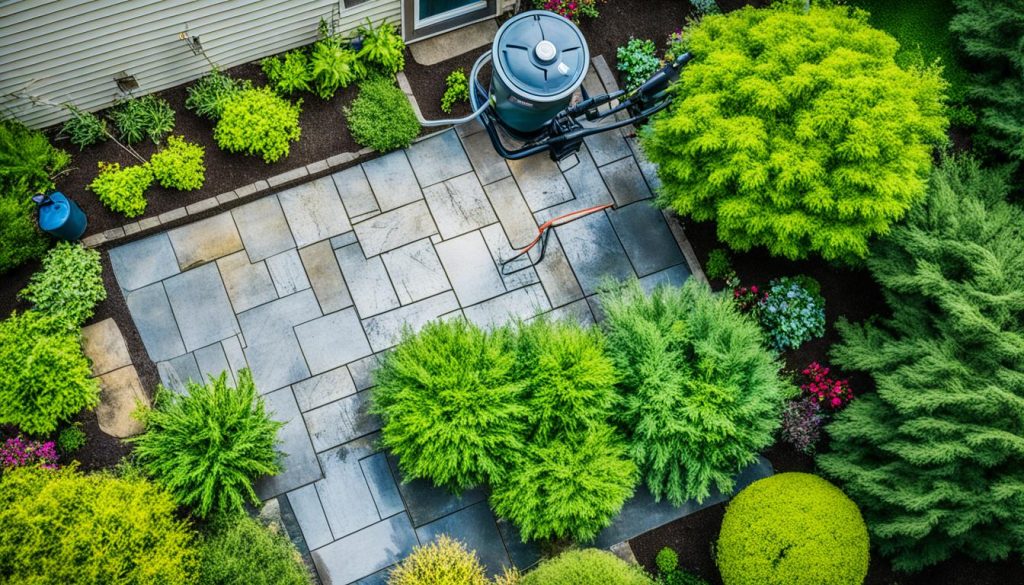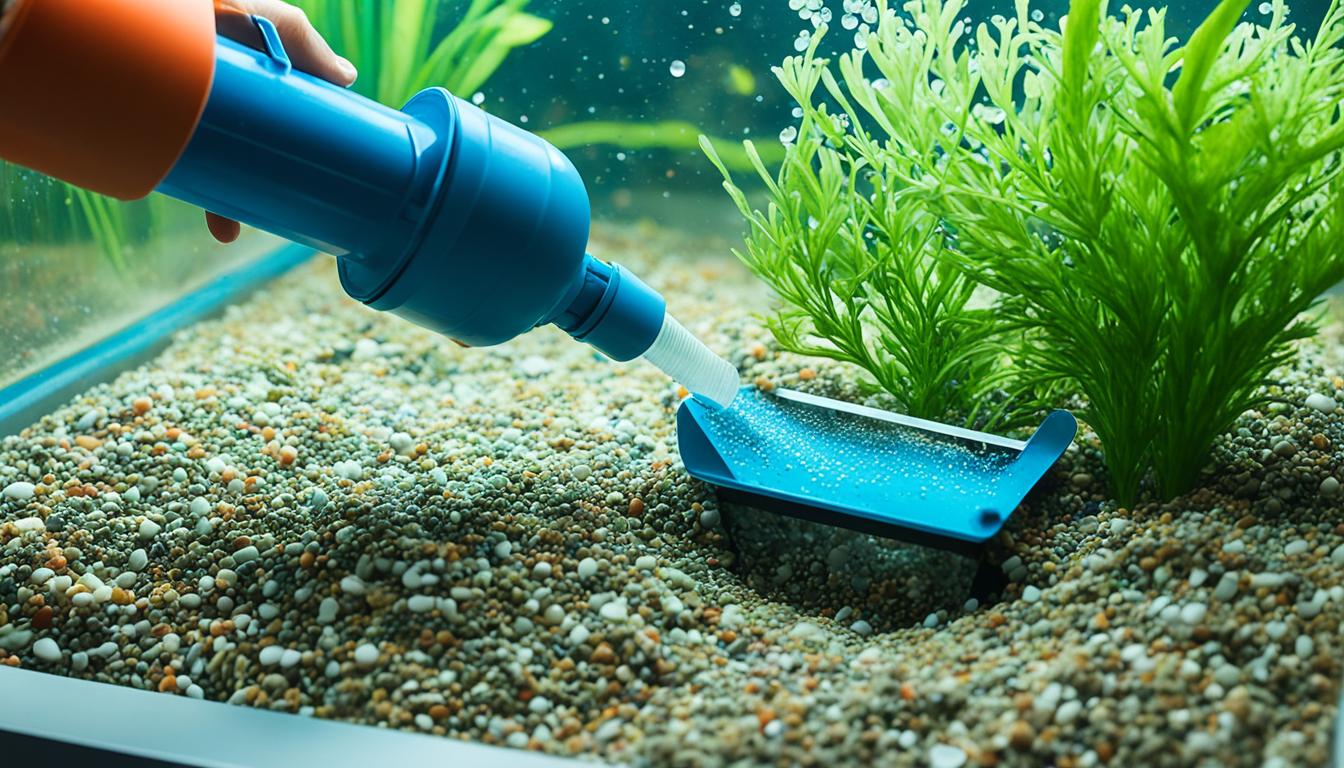Keeping your garden slabs clean is crucial for maintaining a pristine outdoor area. Whether you have concrete or natural stone slabs, regular cleaning is essential to ensure they always look their best. In this comprehensive guide, we will provide you with practical tips and a step-by-step cleaning guide for your patio slabs. From cleaning outdoor paving stones to removing grime effectively, we’ve got you covered.
Before we dive into the cleaning process, it’s important to understand the common issues that arise when dealing with patio slabs. Stains, algae, moss, and weeds can accumulate on the surface as well as in the joints of the slabs, detracting from the overall appearance and safety. By knowing what to look out for, you can identify the appropriate cleaning methods and tools to use.
What to Look Out for When Cleaning Garden Slabs?
Before diving into the cleaning process, it’s important to understand the common issues that arise when dealing with Garden slabs. Stains, algae, moss, and weeds can accumulate on the surface as well as in the joints of the slabs. Not only do these detract from the overall appearance, but they can also pose safety hazards. Knowing what to look out for will help you identify the appropriate cleaning methods and tools to use.
When inspecting your patio slabs, keep an eye out for:
- Stubborn stains
- Discoloration caused by algae or moss
- Weeds and plants growing between the slabs
- Slippery areas that can lead to accidents
Addressing these issues promptly will ensure your Garden slabs remain clean, safe, and visually appealing.

How to Clean Garden Slabs?
Before embarking on the deep cleaning process, it is essential to eliminate coarse dirt from the surface of your Garden slabs. This includes loose debris like leaves, twigs, and other organic matter. By eliminating this dirt beforehand, you prevent it from spreading further during the cleaning process. Brooms made of straw or plastic are ideal tools for this task as they effectively sweep away debris without causing damage to the surface.

Tip: To make the cleaning process easier, it’s recommended to cover any nearby plants or delicate areas with a protective tarp or plastic sheeting.
Why Removing Coarse Dirt is Important?
By removing coarse dirt from your patio slabs, you ensure a clean and even surface for the subsequent cleaning steps. This initial cleaning stage prevents dirt from being ground into the slabs during the deep cleaning process, allowing for a more efficient and effective overall cleaning result.
Tools for Removing Coarse Dirt
Here are some commonly used tools for removing coarse dirt from patio slabs:
| Tool | Pros | Cons |
|---|---|---|
| Broom with straw bristles | Effective at capturing and removing debris | May leave behind small particles |
| Broom with synthetic bristles | Durable and can effectively remove debris | May not capture smaller particles |
| Leaf blower | Quick and efficient debris removal | Can blow debris into unwanted areas |
Note: When using a leaf blower, be mindful of the direction in which you blow the debris to prevent it from scattering onto other surfaces.
Once you have removed the coarse dirt from your patio slabs, you can proceed to the next step of cleaning the joints between the slabs, as discussed in Section 4.
Cleaning Patio Joints
Once the surface of the patio slabs is clear of coarse dirt, it’s time to clean the joints. Weeds, moss, and algae often grow in the joints, making them unsightly and slippery. Using a joint scraper or garden spatula, loosen and remove any debris stuck in the joints. This step can be time-consuming but is crucial to achieving a thorough cleaning. For a simple alternative, hot water can be poured into the joints to kill off the weeds. The joints should be cleaned before proceeding to clean the slabs themselves.
Thoroughly Cleaning Patio Slabs
After preparing the surface and joints, it’s time to thoroughly clean the patio slabs themselves. Various methods can be used, depending on the type of slabs and the level of dirt and stains. Professional cleaning products designed for stone or concrete surfaces are effective in removing stubborn stains such as red wine, grease, or oil. Home remedies such as soap diluted in warm water or homemade cleaners made with bicarbonate soda or vinegar can also be used. Pressure washers or electric patio cleaners provide efficient and time-saving options for thorough cleaning. It’s important to choose the appropriate method for your specific slabs to avoid damage.
If you opt for professional cleaning products, make sure they are suitable for your type of slabs. Follow the instructions on the packaging carefully for optimal results. Home remedies can be a cost-effective and eco-friendly alternative, but always test them on a small, inconspicuous area first to avoid any unexpected reactions or damage.
When using pressure washers or electric patio cleaners, adjust the pressure and select appropriate nozzles or attachments based on the condition of your slabs. Start with a low-pressure setting and gradually increase if necessary. Keep the nozzle or attachment at a safe distance from the slabs to avoid chipping or etching the surface. Move the tool in a sweeping motion, covering the entire slab evenly.
Top Techniques for Rejuvenating Garden Slates:
- Apply a stone-cleaning agent or homemade cleaner, scrubbing the surface with a soft-bristle brush.
- Rinse the slabs thoroughly with clean water, removing any residue.
- If stubborn stains persist, use a pressure washer or electric patio cleaner to blast away the dirt. Adjust the pressure and nozzle distance as needed to avoid causing damage.
- For heavily stained or discolored slabs, consider using a poultice made of cleaning agents specifically formulated for stone surfaces. Apply it to the affected areas, following the instructions provided, and allow it to work its magic before rinsing it off.
- Once the slabs are clean, apply a stone sealant to protect them from future stains and damage. Choose a sealant suitable for your type of slabs and follow the application instructions carefully.

Thoroughly cleaning your patio slabs not only enhances their appearance but also prolongs their lifespan. Regular maintenance and cleaning will keep your garden slates looking brand new and ensure you can enjoy your outdoor space to the fullest. Remember to prioritize safety and choose the appropriate cleaning products and techniques for your specific slabs.
| Cleaning Method | Pros | Cons |
|---|---|---|
| Professional cleaning products |
|
|
| Home remedies |
|
|
| Pressure washers or electric patio cleaners |
|
|
Cleaning Different Types of Garden Slabs
Different types of garden slabs require different cleaning approaches. It’s essential to understand the characteristics of the slabs in your garden to effectively maintain their appearance and cleanliness. Let’s explore the specific cleaning methods for natural stone slabs and concrete slabs:
Natural Stone Slabs
Natural stone slabs, such as granite, marble, sandstone, or limestone, can offer durability and beauty to your outdoor space. However, they are prone to accumulating dirt and green deposits, especially in their indentations. To clean natural stone slabs:
- Start by removing loose dirt and debris from the surface using a broom or brush.
- Consider the hardness of the stone before selecting a cleaning method. Hard stones like granite and marble can withstand high-pressure cleaning, while softer stones like sandstone or limestone should be cleaned with low pressure or by hand.
- For stubborn stains, use a professional stone cleaner or a homemade solution of warm water and mild soap. Apply the cleaner with a soft brush or sponge, scrubbing gently to avoid scratching the stone.
- To remove green deposits or algae, a mixture of warm water and vinegar can be effective. Apply the solution to the affected areas and let it sit for a few minutes before scrubbing and rinsing the slabs thoroughly.
- It’s important to rinse the stone slabs with clean water to remove any residue or cleaning solution.
Regularly inspect and maintain natural stone slabs, as they may require sealing to preserve their appearance and protect them from staining.
Concrete Slabs
Concrete slabs, commonly used for outdoor paving, are highly absorbent and require gentle cleaning methods. To clean concrete slabs:
- Remove loose dirt and debris from the surface using a broom or brush.
- For smaller stains, such as oil or grease, you can use scouring sand. Apply the sand to the stained area and scrub gently with a brush. Rinse thoroughly with water.
- To remove green deposits or algae, mix warm water with mild soap and apply the solution to the affected areas. Scrub with a brush and rinse thoroughly.
- It’s essential to use a small amount of water when cleaning concrete slabs to avoid excessive moisture absorption.
Remember to approach concrete slabs with care to prevent damage, as they may be sensitive to certain cleaning solutions or high-pressure cleaning.
Tips for Cleaning Patio Slabs with Different Methods
When it comes to cleaning outdoor paving slabs and effectively removing grime from garden slabs, it’s crucial to use the right techniques and follow safety precautions. Here are some tips to ensure a successful cleaning process:
1. Soap and Water Cleaning:
For this method, apply the soap and water mixture to small sections at a time. Scrub the surface with a brush, paying attention to any stubborn stains or grime. Rinse the slabs thoroughly to remove all traces of soap.
2. Bleach Cleaning:
When using bleach, it’s important to mix it with water before applying it to the slabs. Ensure that the bleach is evenly spread and avoid contact with surrounding plants or foliage. Rinse the slabs well after cleaning to minimize any residual bleach.
3. Pressure Washing:
Pressure washing is an efficient method for cleaning garden slabs but requires careful adjustments. Set the angle and pressure according to the type of slabs to prevent any damage. Start with a low-pressure setting and gradually increase if necessary. Always wear appropriate protective clothing and ensure proper ventilation when using a pressure washer.
4. Safety Precautions:
When cleaning patio slabs, it’s essential to prioritize safety. Use gloves and protective eyewear to shield yourself from cleaning chemicals and debris. If using cleaning chemicals, read and follow the instructions provided by the manufacturer. Properly dispose of any chemical residue or cleaning waste according to local regulations.
Remember: Always test cleaning methods on a small, inconspicuous area before applying them to the entire surface. This way, you can ensure that the cleaning method is suitable for your specific garden slabs.
By using these tips and techniques, you can effectively clean your patio slabs, removing grime and bringing back their original beauty. Remember to choose the appropriate cleaning method for your specific slabs and take safety precautions to ensure a successful cleaning process.
Conclusion
Keeping your garden slabs clean and well-maintained is essential for creating a beautiful and safe outdoor space. By following the right cleaning methods and using the appropriate tools and products, you can ensure that your patio remains looking fresh and inviting throughout the year.
Regular maintenance is key to preserving the cleanliness of your garden slabs. Removing coarse dirt from the surface with a broom or plastic brush before deep cleaning will prevent it from spreading and causing further damage. Paying attention to the joints and removing any weeds, moss, or algae will not only enhance the appearance of your patio but also reduce safety hazards.
Thoroughly cleaning the patio slabs themselves requires careful consideration of the type of material. Whether you have natural stone slabs or concrete, utilizing the right cleaning techniques will help you tackle stubborn stains, grime, and green deposits effectively. Remember to test any cleaning methods on a small area first and always prioritize safety when handling cleaning chemicals.
With these tips on cleaning and preserving garden patio floors, your garden slabs will be spotless and ready for you to enjoy outdoor gatherings, relaxation, and the beauty of your surroundings.







